25.10.2006
I.Smykovskij. European Club Cup, rounds 1-4
Most games of the starting rounds were played between players of strikingly different level, as it usually happens in Swiss tournaments. Normally this predetermines the result as well as insufficiently tense character of play. However, apart from obvious disadvantages, one can also find some pluses. It is easier to find textbook examples on various topics in such games, because the weaker player shows low level of resistance.
In the following game White concentrated all his forces against the enemy king, and then conducted his attack ideally and without material concerns.
A.Sokolov (2589) – Buchinskas (2333) B93
1.e4 c5 2.¤f3 d6 3.d4 cxd4 4.¤xd4 ¤f6 5.¤c3 a6 6.f4 Јc7 7.¤f3 e6 8.Ґd3 ¤c6 9.Јe2 ¤d7 10.O-O Ґe7 White played an unpretentious opening, but now he shows new and original idea. 11.¤d1!?N. The knight goes to the kingside, at the same time preparing the c2–c4 advance. I don`t think this plan is particularly dangerous for Black, but it calls for certain accuracy. It is interesting to watch how Black gets into a difficult situation and then falls to devastating attack without committing obvious errors. 11...b5 12.¤f2 Ґb7 13.Ґe3 Ґf6?! First inaccuracy. It was not a good idea to attack the b2-pawn at cost of placing the bishop on vulnerable square. 13...0-0 is more sensible.
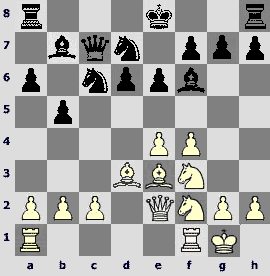
14.c4! An important step of White`s plan – opening the c-file favors him. 14...bxc4 15.Ґxc4 O-O 16.¦ac1 ¤b6? This is already a serious error. The knight stands badly on b6 (remember Dr. Tarrasch). It has to be defended by the queen, and in addition Black moves his pieces away from the kingside, not noticing that White prepares to attack in that direction. 16...¦fe8 does not solve problems due to 17.¤g4, and if 17...Ґe7, then 18.f5 with attack. Stronger is 16...¤c5!, although after 17.f5 White has the initiative. 17.Ґd3 ¦fc8. On 17...d5 White continues 18.¤g4 Ґe7 19.¤ge5±. 18.¤g4 Ґd8 19.¤g5! h6? A crushing defeat cannot be avoided now. Black`s best try is accepting an inferior position after 19...Ґxg5 20.fxg5 ¤d7 (admitting the 16th move mistake) 21.Јf2±.
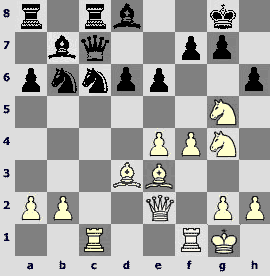
20.¤xh6+!White opens the enemy king and creates irresistible threats by sacrificing both knights. 20...gxh6 21.Јh5 hxg5. Neither 21...ўg7 22.¤xe6+ fxe6 23.f5ќ, nor 21...Ґxg5 22.fxg5 ¦f8 23.gxh6 ўh8 24.Јg5ќ help. Black`s problem in similar variations is that his queen is tied with protecting the b6-knight and cannot join the defense. 22.fxg5 Јd7. 23.e5! cannot be parried. On 22...e5 follows 23.g6 fxg6 24.Јxg6+ Јg7 25.Јe8+ ўh7 26.Јh5+ ўg8 27.Ґh6, winning. Desperate queen sacrifice also does not work: 22...¤e5 23.¦xc7 Ґxc7 24.¦xf7! ¤xf7 25.g6 with checkmate.
23.e5! ¤xe5 24.Јh7+ ўf8 25.g6 Ґf6 26.¦xf6 ¤d5 27.¦xf7+! Јxf7. On 27...¤xf7 White wins by 28.¦f1. 28.Ґh6+ ўe7 29.gxf7 ¦xc1+ 30.Ґxc1. Converting extra material is easy for White. 30...¦f8 31.Ґg5+ ўd7 32.Ґg6 ¤e7 33.Ґh5 ¤f5 34.Ґh6 ¤xh6 35.Јxh6 ўe7 36.Јg5+ ўd7 37.Јg7 Black resigns.
Starting from the second round, the tension began to grow. From now on we will not follow a chronological order and focus on the best games of the participants.
Dmitry Jakovenko scored two convincing victories. He outplayed his opponents positionally, and did not miss a chance to punish them for tactical errors.
Jakovenko (2667) – Berg (2589) C18
1.e4 e6 2.d4 d5 3.¤c3 Ґb4 4.e5 c5 5.a3 Ґxc3+ 6.bxc3 ¤e7 7.Јg4 O-O 8.Ґd3 f5 9.exf6 ¦xf6 10.Ґg5 ¦f7 11.Јh5 g6 12.Јd1 ¤bc6 13.¤f3 Јa5 14.Јd2 Јc7N. This line of the French has a reputation of being difficult for Black. The Swedish grandmaster tries a new idea. 15.O-O cxd4
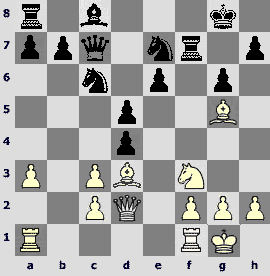
16.¤xd4! Berg`s idea is justified in case of 16.cxd4 ¦xf3! 17.gxf3 ¤xd4 with compensation for a sacrificed exchange. 16...a6. One must cover the b5-square, because 16...e5 is very unpleasantly met by 17.¤b5 followed by c3-c4. 17.¦ae1 e5 18.¤xc6 bxc6. If 18...¤xc6, then 19.c4 d4 20.f4!±. 19.f3! Fixing the pawn on e5, which makes it almost impossible for Black to protect. 19...¤f5 20.Јe2 Јb6+
21.Јf2. A safe move, but 21.ўh1 h6 22.Ґd2 ¦e7 23.g4± was also possible. 21...Јc7. In case of 21...Јxf2+ 22.ўxf2 the central pawn falls. 22.Јc5. A human move that underscores White`s advantage, but 22.g4! followed by 23.Јg3 would have been more efficient. 22...Ґb7 23.¦f2 ¦e8 24.¦fe2 ¤g7 25.Ґh6 ¦fe7. Bad is 25...¤e6? 26.¦xe5, and 25...¦ee7 is strongly met by 26.Ґxg7! ўxg7 27.c4±.
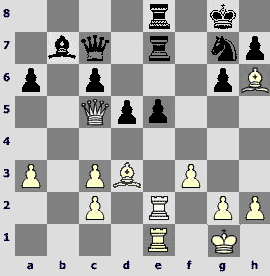
26.Ґf4! Dmitry Jakovenko methodically shakes the opponent`s defense. It is very difficult to defend such position as Black, so no wonder Berg beings making mistakes. 26...ўf7. 26...¤e6? leads to a loss of pawn because of 27.Ґxe5 ¤xc5 28.Ґxc7, and if 26...¤h5, then 27.Ґg5 ¦f7 28.c4±. 27.Ґg3 ¤f5?!Leads to more serious weakening. 27...¤h5 leaves more chances for successful defense: 28.Ґh4 ¤f4 (28...¦e6 29.¦b1 ¤f4 30.¦ee1±) 29.¦e3 g5! (with idea 30.Ґxg5? ¤e6), although White keeps an advantage by 30.Ґg3.
28.Ґxf5 gxf5 29.Јb4!?Creating a threat of taking on e5 and an opportunity to transfer the queen to the kingside. 29.c4 is a viable alternative.29...f4?Thisoverlookisdecisive. One had to seek practical chances by 29...h6 – this move decreases the effectiveness of 30.Јh4, which can be met by 30...f4, and in case of 30.Ґxe5 ¦xe5 31.¦xe5 ¦xe5 32.¦xe5 Јxe5 33.Јxb7+ ўf8 White has to work hard to convert an extra pawn in a queen ending.
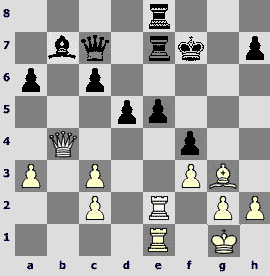
30.¦xe5!Finishing the game by small and neat combination. 30...¦xe5. 30...fxg3 also loses: 31.Јf4+ ўg8 32.¦g5+. 31.Јxf4+ ўg6 32.Јg4+ ¦g5. Or 32...ўf7 33.Ґxe5 ¦xe5 34.Јf4+ ўe6 35.Јh6+, and White wins. 33.¦xe8 ¦xg4 34.Ґxc7. In addition, Black loses the b7-bishop.
34...¦c4 35.¦b8 ¦xc3 36.¦xb7 ¦xc2 37.Ґe5 c5 38.g4 d4 39.¦g7+ ўh6 40.¦g8 Black resigns.
Delchev (2637) – Jakovenko (2667) A37
1.c4 c5 2.g3 ¤c6 3.Ґg2 g6 4.¤c3 Ґg7 5.¤f3 d6 6.O-Oe5 7.a3 Ґe6 8.d3 ¤ge7 9.¦b1 a5 10.Ґd2 O-O 11.¤b5N. Earlier White played 11.¤g5. 11...h6 12.¤e1 Јd7 13.b4?! This early activity yields the initiative to Black. 13...axb4 14.axb4 ¤xb4 15.Ґxb4 cxb4 16.¤c2. 16.e4!? deserves attention, preventing Black`s next move.
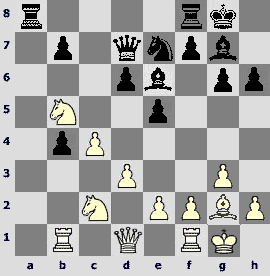
16...d5! 17.cxd5?! Trading the light-squared bishops favors Black. Maybe one has to seek a draw by 17.¤xb4 dxc4 18.dxc4 Јxd1 19.¦fxd1 Ґxc4 20.¤d3. 17...Ґxd5 18.¦xb4 Ґxg2 19.ўxg2 ¤d5. Underscoring another serious White`s problem – the b5-knight is detached from other pieces and requires constant support. This detail will later decide the outcome of the game. 20.¦b1?! Aggravating White`s already difficult situation. One had to over the second rank by 20.¦b2. 20...¦a2. Another tempting idea is 20...¦fc8. White cannot play 21.¤b4, and after 21.¤ca3 ¦c5 22.Јd2 (bad is 22.Јb3 Јc6 23.ўg1 ¤c3! 24.¦b2 ¤xb5 25.¤xb5 ¦a5, and the knight is trapped) 22...¤c7 one cannot play 23.¤xc7? ¦xa3 24.Јb4 ¦aa5 25.¤a8 ¦cb5°. Only 23.Јb4 allows White keeping material balance.
21.¤b4. 21.¤ca3 Јg4! and 21.¤e3 ¤xe3+ 22.fxe3 ¦c8 both favor Black. 21...¤xb4 22.¦xb4 ¦c8 23.ўg1? The last mistake. In case of 23.¦c4 ¦xc4 24.dxc4 Black has a pleasant choice between 24...Јc6+ 25.ўg1 Јxc4 26.¤d6 Јc7 and 24...¦d2 25.Јb3 Јc6+ 26.ўg1 ¦xe2 with an extra pawn in both cases. 23.Јb3 leaves some practical surviving chances: 23...¦cc2 (or 23...¦xe2 24.¤c3 ¦d2 25.¤e4 ¦xd3 26.¦xb7) 24.¤c3 ¦ab2! 25.Јd5 (25.Јxb2? ¦xb2 26.¦xb2 Јc6+ 27.¤e4 f5°) 25...Јxd5+ 26.¤xd5 ¦xb4 27.¤xb4 ¦xe2 28.¦b1 ¦d2 29.ўf3 h5µ.

23...¦a5! Black wins, because White must part with an exchange. 24.Јb3. If 24.Јb1, then 24...¦c5! 24...Ґf8 25.¦b1 Ґxb4 26.Јxb4 ¦a6 27.¤a3 b5 28.ўg2 Јd5+ 29.f3 Јa2 White resigns.
Evgeny Najer started his prophylactic work already in the opening. Having restricted the opponent`s counterplay, he prepared a decisive attack against the centralized king perfectly.
Najer (2677) – Hort (2512) C16
1.e4 e6 2.d4 d5 3.¤c3 Ґb4 4.e5 b6 5.a3 Ґf8 6.¤f3 ¤e7 7.b4!?White prevents Black`s main idea, i.e. trading the light-squared bishops on a6. 7...c6 8.a4!?N. A logical novelty that continues the same strategic course. Earlier White played 8.Ґd3. 8...¤f5 9.¦b1 ¤d7 10.Ґd3 a5. It is hard to advise any other active idea for Black. 11.bxa5 ¦xa5 12.Јe2!Againpreventing 12...Ґa6. One can state that Black failed solving his opening problems. White has small but lasting advantage.
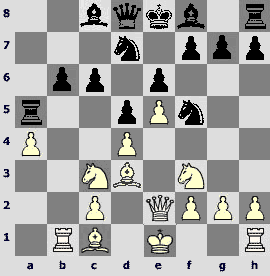
12...g6?! Adubious decision. Black was probably worried about the exchange on f5 followed by e5-e6, but this attempt is double-edged. More natural is 12...Ґe7. 13.h4 h6 14.h5 g5 15.g4 ¤e7 16.Ґa3 Ґb7 17.O-O ¤c8?! Black neutralizes dangerous dark-squared bishop, but loses one more potential defender of his king.
18.Ґxf8 ¦xf8 19.¤d2! A strong maneuver! White moves the knight to b3, after which he can open the position on both wings to his advantage. 19...c5?! This move only assists White. Black position is overall difficult, and yet better is 19...¤e7 20.¤b3 ¦a7, to which White can reply 21.Јe3 with a better game. 20.¤b3 ¦a8?! Black`s loss in this game was determined by series of similar inaccuracies. It was necessary to play 20...¦a7, strengthening the b7-bishop, although after 21.dxc5 ¤xc5 22.¤xc5 bxc5 23.¦fd1 White has a big advantage.
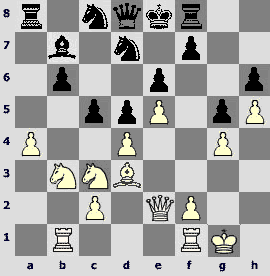
21.¤xc5! The consequences of this piece sacrifice were assessed by Evgeny Najer with great accuracy. 21...bxc5.If 21...¤xc5 22.dxc5 Јc7, then 23.Јe3 bxc5 24.¤e4! d4 (24...dxe4? loses to 25.¦xb7! Јxb7 26.Ґb5+ ўd8 27.¦d1+ ўc7 28.Јxc5+) 25.Јf3 with overwhelming position. 22.¦xb7 c4 23.Ґxc4!Ofcourse, 23.Ґh7 wasnotthegoal. 23...dxc4 24.Јxc4. White has three pawns for a piece, but more important that the opponent is completely helpless against the growing pressure.
24...¤cb6. At attempt to move the king away from the center fails: 24...¦g8 25.¦fb1 ўf8 26.Јc6 ¤db6 27.¦b4, and Black has no sensible moves. 25.Јb5 f5?! Accelerating the finish, but the result would not change in case of 25...¦b8 26.¤e4! ¦xb7 27.¤f6+ Јxf6 (27...ўe7 28.Јb4+) 28.exf6 ¦b8 29.a5 ¤d5 30.Јa4. 26.a5 Јc8 27.¦xb6 Јxc3 28.¦xe6+ ўd8 29.¦d6 Јc7 30.Јd5 ¦a7 31.e6 Black resigns.
Teimour Radjabov employed a rare continuation in the opening, and then with surgical precision neutralized the initiative of Alexander Morozevich, who dared to sacrifice an exchange. It was not easy for me to analyze this game, which was decided by fine nuances.
Radjabov (2728) – Morozevich (2731) B82
1.e4 c5 2.¤f3 e6 3.d4 cxd4 4.¤xd4 ¤c6 5.¤c3 d6 6.Ґe3 ¤f6 7.f4 Ґe7 8.Јf3 e5 9.¤xc6 bxc6 10.f5 Јa5 11.Ґc4 ¦b8 12.Ґd2!?A rare move. Normal continuation is 12.0-0-0 0-0 13.Ґb3 with mutual chances.
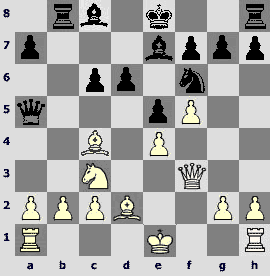
12...¦xb2N. Such exchange sacrifice is typical for this system. Earlier Black preferred a passive 12...Јc7?! 13.Ґb3.One can win the material in a different way – 13.¤d1 Јb6 (this is more accurate than 13...¦b4 14.a3 d5 15.¦b1 ¦xb1 16.Ґxa5 dxc4 17.0-0, and there is no sufficient compensation for a queen) 14.Ґb3 ¦xb3 15.axb3 d5. It seems Radjabov`s choice is stronger. 13...¦xb3. 13...Јa6!? 14.0-0-0 Јa3 15.¤b5 ¦xb3+ 16.¤xa3 ¦xf3 17.gxf3 d5 or 14.¤a4 ¦xb3 15.axb3 d5 lead to an unclear game. It is possible that Morozevich wanted to force his opponent taking on b3 with the c-pawn. 14.cxb3 Јa6 15.g4 h6 16.Јg3!? White removes the queen from the h1-a8 diagonal, cutting some tactical ideas associated with d6-d5.
16...Ґb7 17.O-O-O. Radjabov consolidates the position and begins pushing the kingside pawns. Black counterplay worth less than an exchange. 17...c5 18.¦he1 c4 19.ўb2 ¤d7? Black removes the pressure from central squares, and his position becomes very difficult after White`s next move. One should have played 19...0-0, having in mind 20.g5 hxg5 21.Ґxg5 ¦c8! (weaker is 21...cxb3? 22.axb3 ¦c8 23.¦a1! Јb6 24.Јe3) 22.b4 d5! or 20.b4 Ґc6!? followed by 21...Јb7. It is more difficult for White to prove his advantage in both of these lines. 20.b4! Јb6 21.ўa1. In case of 21...0-0 22.h4 White develops his attack easily. 21...Јd8 22.Јe3 ¤b6
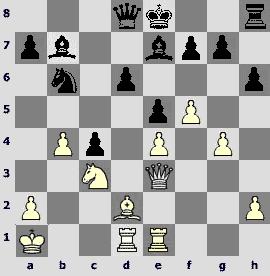
23.Јg1!? Preparing for decisive opening of the files. 23...O-O 24.g5! Ґxg5 (24...hxg5 25.Јg4 d5 (or 25...Ґf6 26.¦g1 d5 27.h4) 26.h4 d4 27.hxg5 dxc3 (27...Ґxb4 28.¦h1 f6 29.g6ќ) 28.Ґxc3 Јc7 29.¦h1ќ) 25.Ґxg5 hxg5 26.Јe3 f6 27.h4! gxh4 28.¦h1 d5 29.exd5 Јd7 30.Јf3 Ґc8 31.¦df1 Јe7 32.a3 e4. Nothing is changed by 32...a5 33.¦xh4 axb4 34.¦fh1 Јc5 35.¦h8+ ўf7 36.Јh5+ ўe7 37.Јh7ќ. 33.Јf4 ¦d8 34.¦fg1 Јe5 Black resigns.
It is hard to remain unimpressed by games of Alexander Morozevich. He countered experience of the Bulgarian grandmaster by his innate skill to complicate the game and precise calculation.
Morozevich (2731) – Kir.Georgiev (2685) C45
1.e4 e5 2.¤f3 ¤c6 3.d4 exd4 4.¤xd4 Ґc5 5.Ґe3 Јf6 6.c3 ¤ge7 7.¤c2. An ancient continuation reputed as completely harmless for Black. 7.Ґc4 is much more common. 7...Ґxe3 8.¤xe3 Јe5 9.¤d2 d5 10.Ґd3!? White has nothing against playing a position with open center, judging that his minor pieces are better coordinated. 10...dxe4 11.Ґxe4 Ґe6
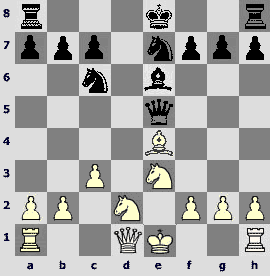
12.Јc2!?N. Ivanchuk-Anand (Monaco 2005) continued 12.Јa4 0-0-0 13.¤f3 Јh5 14.0-0 f5 with approximately even chances. Alexander Morozevich places his queen to enhance the queenside expansion. 12...O-O-O 13.¤f3 Јb5. Black should consider 13...Јh5 14.0-0 f5, following Anand`s play in the pioneer game. 14.b4. On 14.a4 Black planned to simplify the position by 14...Јb3. 14...¦he8 15.a4 Јh5 16.O-O f5 17.Ґxc6 ¤xc6 18.b5 ¤a5 19.¤d4. White secured a stronghold in the center, but Black keeps sufficient counterchances associated with the f-pawn advance. 19...f4 20.¤ef5 Ґxf5 21.¤xf5 Јg6 22.¦ae1 ўb8
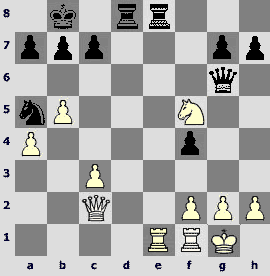
23.¦e4! Morozevich provokes the fire. After 23.¦xe8 ¦xe8 24.Јd3 ¤c4 drawing tendencies prevail. 23...f3 24.g3. The f3-pawn is more a weakness than strength. 24...b6? It seems this is a first serious positional mistake of Black. 24...¤b3!? led to unclear consequences. 25.¦f4! White wins a pawn, not being disturbed by the second rank invasion of enemy rooks. 25...¦e2?!It is difficult to resist such move, but in retrospect one wants to suggest 25...¦e5!? 26.¦xf3 ¤c4 with compensation for a pawn. 26.Јb1 ¦dd2. Black`s initiative seems dangerous, but White assessed the complications correctly. 27.¦xf3 ¦b2
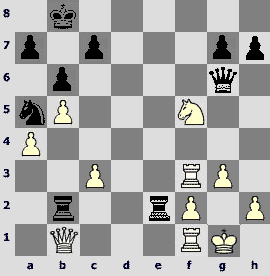
28.Јd1! This impressive maneuver saves the queen from attacks. 28.Јc1 runs into 28...¤b3. 28...¦ed2. If 28...¦bd2, 29.Јc1 provides the queen with the a3-square. 29.Јa1! ¦a2. Also after 29...¤b3 30.Јa3 ¤c5 31.¤d4! Black is in trouble. 30.Јe1! ¦e2 31.Јc1! ўb7. Now 31...¤b3 is replied by 32.Јd1! 32.Јf4. It turns out that Black has no objects of attack, and his rear is too weakened.
32...¤b3 33.¦d3 Јe6?! More tenacious 33...Јe8 can be met by spectacular 34.Јf3+ Јe4 (34...ўb8 35.¦fd1ќ) 35.¦d7!! ¦ad2 36.Јxe4+ ¦xe4 37.¦xg7 with technical win. 34.¦d8 ¦ad2. If 34...¦e4, then 35.¤xg7. 35.¦h8! Preparing for a decisive combination. 35...Јe4. This loses at once, but Black`s position is hopeless anyway.

36.¤d6+! The queen breaks to a back rank with devastating effect. 36...cxd6 37.Јf8 Јe8 38.Јxe8 Black resigns.
Here is another example of unexpected attack with limited material. One should also note good opening preparation of Mamedyarov.
Naiditsch (2664) – Mamedyarov (2722) B44
1.e4 c5 2.¤f3 e6 3.d4 cxd4 4.¤xd4 ¤c6 5.¤b5 d6 6.c4 ¤f6 7.¤1c3 a6 8.¤a3 Ґe7 9.Ґe2 O-O 10.O-Ob6 11.Ґe3 Ґb7 12.Јb3 ¤d7 13.¦fd1 ¤c5. This is all book. White cannot play 14.Ґxc5? bxc5 15.Јxb7?? because of 15...¤a5. 14.Јc2 Ґf6 15.¦ac1 Ґe5. The complications after 15...Ґxc3 16.Јxc3 ¤xe4 17.Јd3 favor White. 16.¤ab1 f5!? Karpov-Olafsson (Amsterdam 1976) continued 16...Јh4 17.g3 Јf6 18.f4 Ґd4 19.Јd2 e5 20.¤d5, and White got an advantage. 17.f4.If 17.exf5 ¦xf5 18.Ґg4, then Black can select 18...Јh4 19.h3 ¦f6 with a comfortable game. 17...Ґxc3 18.¤xc3 fxe4 19.a3 e5!N 19...Јc7 occurred in a correspondence game. Shakhriyar Mamedyarov establishes his with to fight for the initiative.
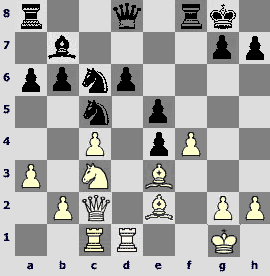
20.¤d5. Wrongis 20.¤xe4? ¤d4. On 20.b4 Black can select between 20...¤d3 and 20...exf4. Maybe 20.g3!? ispossible, too. 20...¤d4.The position simplifies by force, after which the chances are approximately even. 21.Ґxd4 exd4 22.¦xd4 ¤e6 23.¦xe4 Ґxd5 24.cxd5 ¤xf4 25.Ґf3?! Safer is 25.Ґg4 Јg5 26.Ґe6+ ўh8=.
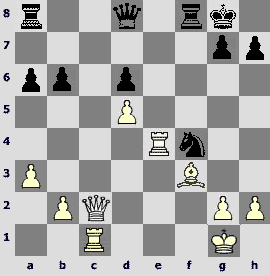
25...Јg5!? Black wants to attack. 25...¤h3+ 26.ўh1 ¤g5 led to a marginal advantage. 26.¦ee1 ¦f6 27.ўh1 ¦af8 28.Ґe4?Asuddenfinale. One had to entrench by 28.¦cd1 ¦h6 29.Јf2. Now Black creates decisive threats. 28...¦h6. White has no adequate defense against 29...Јg3! – 29.¦e3 ¤xg2, 29.Јc3 Јh5 30.h3 ¤e2. 29.¦f1 ¦xh2+! White resigns, as 30.ўxh2 is replied by 30...Јh5+ and 31...¤e2+ winning the queen.
Alexey Shirov continues playing in his active style. He created a powerful offensive against the opposing king, leaving his own monarch in the center.
Shirov (2716) – Roiz (2611) B30
1.e4 c5 2.¤f3 ¤c6 3.¤c3 e5 4.Ґc4 Ґe7 5.d3 d6 6.¤d2 Ґg5 7.h4 Ґh6 8.Јh5 Јd7.Araremove. More regular 8...g6 9.Јd1 leads to a slightly better game for White. 9.¤d5 ¦b8 10.c3 b5 11.Ґb3 ¤ce7 12.¤e3 ¤c6N. In Leko-Kramnik (Monaco 2004) Black obtained an acceptable position after 12...c4 13.dxc4 Ґxe3 14.fxe3 ¤f6 15.Јf3 0-0 16.0-0 Ґa6. 13.¤df1 ¤f6 14.Јf3 O-O
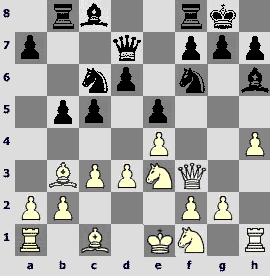
15.g4! Shirov`s play is purposeful and energetic. 15...Ґxe3?! 15...¤xg4? loses – 16.¤xg4 Ґxc1 (or 16...Јxg4 17.Јxg4 Ґxg4 18.Ґxh6 gxh6 19.¦g1) 17.¤f6+ gxf6 18.¦g1+ Ґg5 19.Јxf6. The best move is 15...Ґf4! 16.g5 ¤g4 17.¤f5, and now 17...g6 18.Ґxf4 gxf5 19.Ґd2, or 17...Ґxc1 18.¦xc1 g6 19.¤h6+ ¤xh6 20.gxh6, with small advantage to White in both cases. 16.¤xe3 ¤e7. Black ends up in a difficult position after 16...¤xg4 17.¦g1 h5 (17...¤xe3 18.Ґxe3 ¤e7 19.h5±) 18.Јg3± threatening 19.f3. 17.g5 ¤e8?!Very passive, although 17...¤g4 18.h5 ¤xe3 19.Ґxe3 Јg4 20.Јxg4 Ґxg4 21.f4!? gives White a clearly better ending. After the text-move the attack develops naturally. 18.h5 Ґb7 19.¤g4 c4
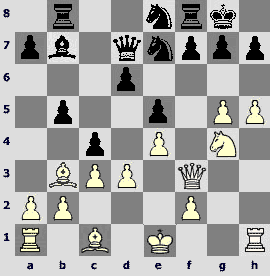
20.h6! Paying no attention to the opponent`s actions. 20...Јf5! Thebestchance. Everything else loses quickly, i.e., 20...cxb3? 21.hxg7 ўxg7 22.¤f6 ¤xf6 23.gxf6+ ўh8 24.¦xh7+! ўxh7 25.Јh5+ ўg8 26.Јg5+! ¤g6 27.Јh6 with checkmate, or 20...f5? 21.hxg7 ўxg7 22.Јh3 ¦h8 23.¤f6ќ. 21.Јh3 Јg6 22.hxg7 ўxg7 23.Јe3! Threatening 24.¦h6. 23...h5. 23...¤g8 24.Ґc2 promises Black nothing.
24.Ґc2 hxg4? Black gives up a queen, and now can safely resign. However, after 24...f6 25.gxf6+ ¤xf6 26.Јh6+ ўg8 (or 26...ўf7 27.¤xf6 ўxf6 28.Ґg5+ ўf7 29.Јxg6+ ¤xg6 30.dxc4 bxc4 31.¦xh5) 27.¤xf6+ ¦xf6 28.Јxh5 White shouldn`t have problems converting his material advantage. 25.¦h6 ¦h8 26.¦xg6+ ¤xg6 27.Јxa7 ¤c7 28.Ґe3 b4 29.dxc4 bxc3 30.bxc3 g3 31.O-O-O g2 32.f4 exf4 33.Ґd4+ ¤e5 34.Јa5 ¤e6 35.Ґxe5+ dxe5 36.Јxe5+ ўg6 37.Јf5+ ўh5 38.¦g1 Black resigns.
Let us turn to opening disasters. Vassily Ivanchuk`s opponent rejected principled lines associated with winning a pawn, and then made a serious error. This was enough to secure the outcome of the game already by the 15th move.
Ivanchuk (2734) – A.Sokolov (2589) E20
1.d4 ¤f6 2.c4 e6 3.¤c3 Ґb4 4.f3 d5 5.a3 Ґxc3+ 6.bxc3 c6.The main line is 6...c5 7.cxd5 ¤xd5 8.dxc5 Јa5 9.e4 with a complex game, but the text-move is also not uncommon. 7.e4!?The most principled move. Curiously, Ivanchuk selects the line invented by his teammate Sergey Volkov. 7...dxe4 8.fxe4 e5 (8...¤xe4? 9.Јg4) 9.¤f3 Јa5 10.Јd3 ¤bd7N. Black rejects 10...cxd4 11.Ґd2!, where White has good compensation for a sacrificed pawn, Volkov-Dautov (Batumi 1999) and Volkov-Genov (Corinth 2002).
11.Ґd2 b6. 11...0-0 looks more natural. 12.Јc2! White wants to arrange his pieces ideally, and obtains a clear plus. 12...O-O 13.Ґd3 ¤e8? Obviously underestimating White`s15th move, Black runs into a critical situation. The position after 13...Ґb7 14.0-0 ¦fe8 is not to his liking, but there is nothing better. 14.O-O ¤d6
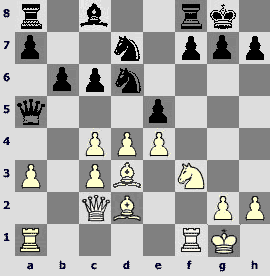
15.c5! White opens the game, and his two bishops begin to tell. The game is won. 15...¤e8. 15...bxc5 16.c4 Јc7 17.dxe5 brings no consolation to Black. 16.c4 Јa6 17.cxb6 axb6. Not better is 17...Јxb6 18.¦ab1. 18.c5 b5. After 18...Јb7 19.cxb6 both 19...Јxb6 20.¦ab1 Јc7 21.Ґb4, and 19...exd4 20.¦ab1 c5 21.e5 are bad. 19.a4 ¤c7. Hopeless is 19...exd4 20.axb5 Јxa1 21.¦xa1 ¦xa1+ 22.ўf2ќ.
20.d5! cxd5 21.exd5 ¤xd5 22.Ґxh7+ ўh8 23.¤g5 ¤7f6. The last chance is 23...g6!?. 24.Јd3 ¤7f6 and 24.axb5 Јxa1 25.¦xa1 ¦xa1+ 26.ўf2 ¤7f6 are less clear, but 24.Јe4! wins: 24...¤7f6 25.Јxe5 b4 (otherwise 26.axb5 or 26.Ґc3) 26.Јd4ќ; 24...¤5f6 25.Јh4 ўg7 (25...¤h5 26.¤xf7+ ўxh7 27.Јe7ќ) 26.¤e6+! Јxe6 (or 26...fxe6 27.Ґh6+) 27.Јh6+ ўh8 28.Ґxg6+ ўg8 29.Ґf5 followed by 30.¦f3. 24.Ґe4! Black resigns.
Winning a pawn in a topical line of the Grünfeld caused serious developmental problems for Black, and soon his game was lost. Alexander Moiseenko scored a strikingly easy win, although experienced Semyon Dvoirys clearly played below his usual strength.
Moiseenko (2649) – Dvoirys (2540) D80
1.d4 ¤f6 2.c4 g6 3.¤c3 d5 4.Ґg5 ¤e4 5.Ґh4.Recently White often seeks an opening advantage in this line. 5...¤xc3 6.bxc3 dxc4 7.e3 Јd5?! A risky move. 7...Ґe6 is much more common. 8.Ґe2 Јa5. Recently in Jobava-Svidler (Dortmund 2006) Black encountered difficulties after 8...Ґg7 9.¤f3 ¤d7 10.0-0 ¤b6 11.a4 a5 12.¤d2. 9.¤f3!N. Much stronger than meek 9.Јc1.
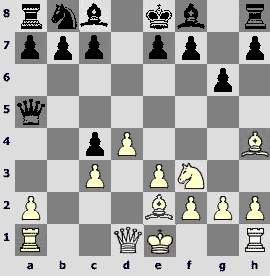
9...Јxc3+. Consistent, but it leads to dangerous lag in development. 10.¤d2 c6 11.O-O Јa5. 12...b5 is ill-advised in view of 13.a4. 12.¤xc4 Јd8 13.Јb3 Ґg7 14.Јa3. Preventing the opponent from castling short. 14...Ґf8?! Such move is poor by definition. However, after 14...f6 15.¦ab1 b5 (defending against 16.¤b6!; in case of 15...¤d7 there is 16.Ґf3 0-0 17.d5±)16.¤a5 White has a big advantage.

15.d5! A spectacular position. It seems White has about a dozen extra tempi, and the time for active operations has come. 15...cxd5? The last mistake. One can resist only by 15...f6, although after 16.dxc6 ¤xc6 17.¦fd1 Black`s position is hardly enviable. 16.Јc3 f6. 16...d4 is a bit more tenacious. White has to play 17.exd4, creating a couple of threats: 18.d5 and 18.¤d6+. 17...¤a6 can be replied by 18.d5 f6 19.d6 Ґg7 20.dxe7 Јxe7 21.¦fe1 with a won position – on 21...0-0 there is 22.¤b6!ќ. 17.¤d6+! Јxd6 18.Јxc8+ ўf7 19.Ґb5 Ґg7.Or 19...Јb6 20.Ґe8+ ўg7 21.¦ab1. 20.Јxb7 ¦d8 21.Јxa8 Јb4 22.¦ab1 Јxh4 23.Ґe2 f5 24.g3 Black resigns.
There were quite a few interesting game in the women`s tournament. I would like to present two tense tactical games with theoretical relevance.
Chmilyte (2476) – Dzagnidze (2437) E12
1.d4 ¤f6 2.c4 e6 3.¤f3 b6 4.a3 Ґb7 5.¤c3 d5 6.cxd5 ¤xd5 7.Јc2 c5 8.e4 ¤xc3 9.bxc3 ¤c6.Solid 9...¤d7 occurs more frequently. 10.Ґb2 ¦c8 11.¦d1 cxd4 12.cxd4 Ґd6 13.d5!? Both players have no fear of arising complications.
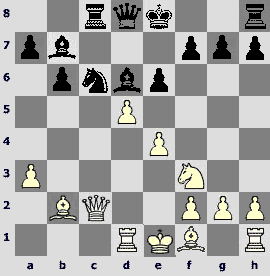
13...exd5 14.exd5 Јe7+ 15.Ґe2 ¤a5 16.Јa4+ ўd8! 17.Ґxg7 ¦g8! Theoretical recommendation 17...¦с4 is challenged by 18.Јb5 ¦g8 19.Ґd4! Now 19...¦xg2 20.ўf1 loses material (the d4-bishop disrupts cooperation of Black`s rooks!), and 19...¦c2 20.ўf1 Ґxd5 (if 20...¤b3, then 21.Ґe3) is unpleasantly met by 21.Ґe5 Ґxf3 22.gxf3! (less fearful for Black is 22.Ґxf3 ¦c5! 23.Ґxd6 ¦xb5 24.Ґxe7+ ўxe7) 22...¦g6 23.¦g1±. 18.Јd4 ¤b3N. Formally a novelty, but actually this is the only sensible move. In Naumkin-Adorjan (Kusadasi 1990) White won after the opponent made a bad blunder 18...¦c2?? 19.Ґf6ќ. 19.Јb2 ¦xg7! Wrong is 19...Ґxa3? due to 20.d6! 20.Јxg7 ¦c2

21.Јg8+? After 21.¤g1? Ґa6 22.Јg4 Black has a very beautiful win 22...h5!, and if 23.Јxh5, the game may end in a smothered mate: 23...Ґb4+! 24.axb4 Јxb4+ 25.ўf1 ¤d2+ 26.ўe1 ¤f3+ 27.ўf1 Јe1+! 28.¦xe1 ¤d2#. Correct 21.0-0! ¦xe2 22.¦fe1 f6 23.Јh8+ ўc7 24.¦xe2 Јxe2 25.Јxh7+ Јe7 26.Јxe7+ Ґxe7 27.h4 leads to a complex ending with a small advantage for White due to a strong passed h-pawn. The text-move removes the queen from g7 prematurely.
21...ўc7 22.O-O. 22.¤g1? Ґa6 is still bad for the same reasons as stated above. 22...¦xe2 23.Јxh7. Nowafter 23.¦fe1 ¦xe1+ 24.¦xe1 Blackhas 24...Јf6! White cannot use his passed pawns with the queens on board, and Black`s initiative is really dangerous. 23...Ґa6 24.¦fe1 ¤d2!?
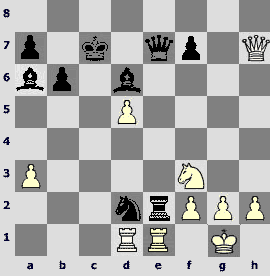
25.Јc2+? White lost this game because of unnecessary checks. After the best try 25.¦xe2 ¤xf3+ 26.gxf3 Ґxe2 27.¦c1+ followed by 28.Јf5 he can still hope for favorable result. 25...ўd8 26.¦xe2 ¤xf3+ 27.ўf1. It transpires that after 27.gxf3? Ґxe2 Black wins immediately. White prefers to concede the h2-pawn, but this loses too. 27...¤xh2+ 28.ўe1 Ґxe2 29.Јxe2 ¤g4. 29...Јg5! is more perfect, but with the text-move Black obtains a technically won ending.
30.Јxe7+ ўxe7 31.¦d4 ¤f6 32.ўe2 b5 33.¦d3 Ґc5 34.ўf3 ўd6 35.g4 ¤d7 36.ўg3 ¤e5 37.¦b3 a6 38.f4 ¤c4 39.g5 Ґxa3 40.f5 Ґc1 41.g6 fxg6 42.fxg6 Ґh6 43.ўg4 Ґg7 44.ўf5 ўxd5 45.¦d3+ ўc6 46.ўe6 b4 47.¦d8 b3 48.¦c8+ ўb5 49. ¦b8+ ¤b6 White resigns.
Т.Kosintseva (2479) – Lahno (2449) C78
1.e4 e5 2.¤f3 ¤c6 3.Ґb5 a6 4.Ґa4 ¤f6 5.O-Ob5 6.Ґb3 Ґc5 7.c3 d6 8.d3 O-O 9.Ґg5 h6 10.Ґh4 g5!?A typical tool of the Archangelsk Variation of the Ruy Lopez. However, it is more effective when White cannot play d3-d4, while here this advance is not completely ruled out. 11.Ґg3 Ґg4 12.¤bd2 Ґb6N. Anewmove. At the recent Olympiad, Akopian-Svidler and Kasimjanov-I.Sokolov tested 12...Јd7 and 12...¦b8. 13.¦e1 ¤e7 14.¤f1 Јd7 15.d4! White easily fulfills the main strategic idea, but Black has real counterplay.

15...exd4 16.cxd4 Ґa5 17.¦e3 Ґh5. This position is not easy to assess. White has a strong pawn center, but her rook is placed awkwardly. 18.h4!? The most active, although other, more modest moves, are also plausible, for instance, 18.h3. 18...d5.Black secures the f5-square for his knight, but weakens the e5-square. 18...g4!? 19.¤3d2 Ґg6 with mutual chances deserves consideration. 19.exd5 ¤f5 20.¦e5 gxh4! Acorrectdecision. Here 20...g4?! could be met by a promising exchange sacrifice: 21.Ґc2 ¤e7 22.¦xh5! ¤xh5 23.¤e5 or 21.¦xf5 Јxf5 22.¤e3 followed by 23.¤e5, with advantage to White in both cases.
21.Ґf4 ¤g4? However, this self-suggesting move brings Black a very difficult position, because the threat of taking on e5 is irrelevant here. One should select between 21...Ґb6 and 21...h3!? 22.¤xh4! It turns out that 22...¤xe5? is bad: 23.Јxh5 ¤xh4 24.dxe5ќ. 22...¤g7? is also unsatisfactory: 23.¤g3! ¤xe5 24.¤xh5 ¤xh5 25.Ґxe5 ¤g7 26.Јf3ќ, so with her next move she admits the mistake. 22...¤f6 23.¤f3 Ґb6. On 23...¤g4 24.Јb1! is very strong: 24...¤xe5 25.¤xe5 Јc8 26.¤c6 or 24...Ґg6 25.Ґc2. 24.¤g3 Ґxf3
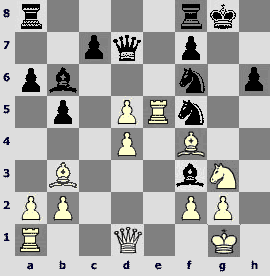
25.Јxf3? This natural recapture drops the advantage. After 25.gxf3! Black is lost: 25...¤xd4 26.Ґxh6 ¦fe8 27.¦g5+ ўh7 28.ўg2! ўxh6 29.Јd2; 25...¤h4!? 26.Ґxh6 Јh3 (26...¦fe8 27.ўh2) 27.¦g5+ ўh7 28.Ґc2+! ўxh6 29.¦h5+! ¤xh5 30.Јd2+ ўg7 31.¤xh5+ ўg8 32.Јg5+ ¤g6 33.Ґxg6; 25...¤xg3 26.fxg3 ¦fe8 27.Јd2 – White wins in all the variations. 25...¤xd4 26.Јd3 ¤g4?! A significant inaccuracy, which was not utilized by White. Strongeris 26...¦ae8, andonlyon 27.¤e4 – 27...¤g4.
27.¤e4?! Of course, it is not easy to spot 27.Ґd1! at the board. The game can follow 27...¤xe5 28.Ґxe5 ¤c6 29.¤h5! ¤xe5 30.Јg3+ ¤g4 31.¤f6+ ўg7 32.¤xd7 Ґxf2+ 33.Јxf2 ¤xf2 34.ўxf2 ¦fd8 35.Ґg4±. 27...¦ae8 28.Ґd1!? This gave White a victory, but only after another mistake by Black. 28.¤g5? f5 29.d6+ ўg7µ leads nowhere, but one has to check 28.d6!?
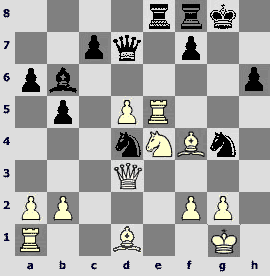
28...f5? A decisive error. Bad is 28...¤xe5? 29.¤f6+ ўg7 30.Ґxe5ќ, but after 28...¦xe5! 29.Ґxe5 (29.Ґxg4 Јe7 30.Ґxe5 Јxe5і) 29...Јxd5 White is at risk. Also 30.Ґxd4 Јxd4 31.Јxd4 Ґxd4 32.Ґxg4 f5 and 30.Ґf4 ¦e8! are in Black`s favor. It seems, one should play 30.Ґxc7 Ґxc7 31.Ґxg4 f5 32.¤g3!? hoping for 32...fxg4 33.Јg6+ with perpetual. 29.Ґxg4 fxg4 30.¦xe8 Јxe8 31.Ґxh6 ¦f5 32.¦e1. The situation has finally clarified. White converted her advantage with ease.
32...Јg6 33.¤g3 ¦f6 34.Јxg6+ ¦xg6 35.Ґf4 ўf7 36.¦e4 c6 37.Ґe3 c5 38.b4 ¤c2 39.Ґxc5 Ґxc5 40.bxc5 ¦g5 41.¦f4+ ўg6 42.c6 ¦xd5 43.¦xg4+ ўh6 44.c7 ¦c5 45.¤f5+ Black resigns.
In the end of the review I will present two interesting fragments from the same match. In both cases the result was influenced not only by purely chess evaluation, but also by nervous atmosphere of important competition, heated by time pressure...
Bologan (2645) – Kozul (2593)

38...¦xc3!? The sacrifice is sound, but not necessary. I can suggest 38...Јa7 39.¤d5+ ўf8 with a good game for Black as an alternative. 39.¦xc3 Јxe4+ 40.¦c2? A blunder that leads to a quick defeat. It was necessary to play 40.¦d3 Јxe4 41.Јc2, getting rid of the pin with unclear position. 40...d5. Now White has nothing to counter simple pushing of the d-pawn. 41.Јe2? is impossible in view of 41...Јh1+. Black wins after 41.ўa1 Ґe3!, too. 41.Јf1 d4 42.h3 Ґg5 43.g4 h4 44.Јg1 ўf8! Black brings the king to safety, after which d4-d3 follows with decisive effect. The rook cannot leave the second rank, because the Black`s queen will invade then. 45.Јf1 d3 46.¦c4 Јe3° also does not help, therefore White resigned.
Nedev (2508) – Tkachiev (2645)

Quiet flow of the game was disturbed at this moment. 21.g4!? White does not want spending time on protecting the a-pawn. After 21.¦xd8 ¦xd8 22.¦e2 the chances are even. 21...Јxa2 22.c4 Јb2?! Allowing domination of White`s pieces in the center. Stronger is 22...¦xd1 23.¦xd1 Јa3!, attacking on c4. In this case White would have to find arguments supporting his decision taken on the 21st move.
23.f5 Ґc8 24.Ґd5!Now White has more than adequate compensation for a sacrificed pawn. 24...Јf6 25.Јg3 ¦de8 26.¤e4 Јb2?!On 26...Јe5 one can play 27.Јf2!?, but this is better for Black than the game. 27.f6 ¤b4?! 27...Јe5 is still better. 28.g5 g6? This move could become a decisive error. There still was defense: 28...¤xd5, although after 29.gxh6 g6 30.¦xd5 c6 31.¦d2 Јe5 32.Јh4 White has a big advantage.
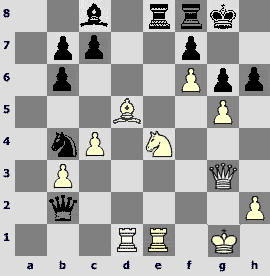
29.gxh6? Amnesty! 29.Ґxf7+! ¦xf7 30.¤d6!! ¦xe1+ 31.Јxe1 wins on the spot. 29...Ґf5 30.h7+ ўh8 31.¤g5 ¦xe1+ 32.¦xe1
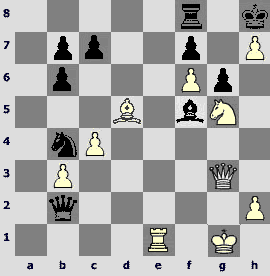
32...Јd4+? Black is killed by an intermediate check. One had to play 32...Јxf6 at once, and then 33.¤xf7+ ¦xf7 34.Ґxf7 Јxf7 35.Јc3+ Јg7 36.Јxg7+ (36.¦e8+ ўxh7 37.Јxb4 Јd4+ draws) 36...ўxg7 37.¦e7+ ўh8 38.¦xc7 Ґe4 39.ўf2 – of course, this ending is clearly better for White, but the struggle goes on. After the text-move the game is over. 33.Јe3 Јxf6. Hopeless is 33...Јxe3+ 34.¦xe3 ¤xd5 35.cxd5ќ. 34.¤xf7+! ¦xf7 35.Ґxf7 ўxh7. On 35...Јxf7 geometric 36.Јd4+ ўxh7 37.Јh4+ ўg8 38.Јd8+ nets a queen. 36.Јe7. Converting an extra exchange is very simple.
36...Јd4+ 37.ўh1 ¤c6 38.Јe8 Јc3 39.Ґd5 Ґg4 40.Јf7+ ўh6 41.Јf4+ ўh5 42.¦e3 Јa1+ 43.ўg2 ¤d4 44.Јe5+ ўh4 45.Јf6+ ўh5 46.Јh8+ Black resigns.
